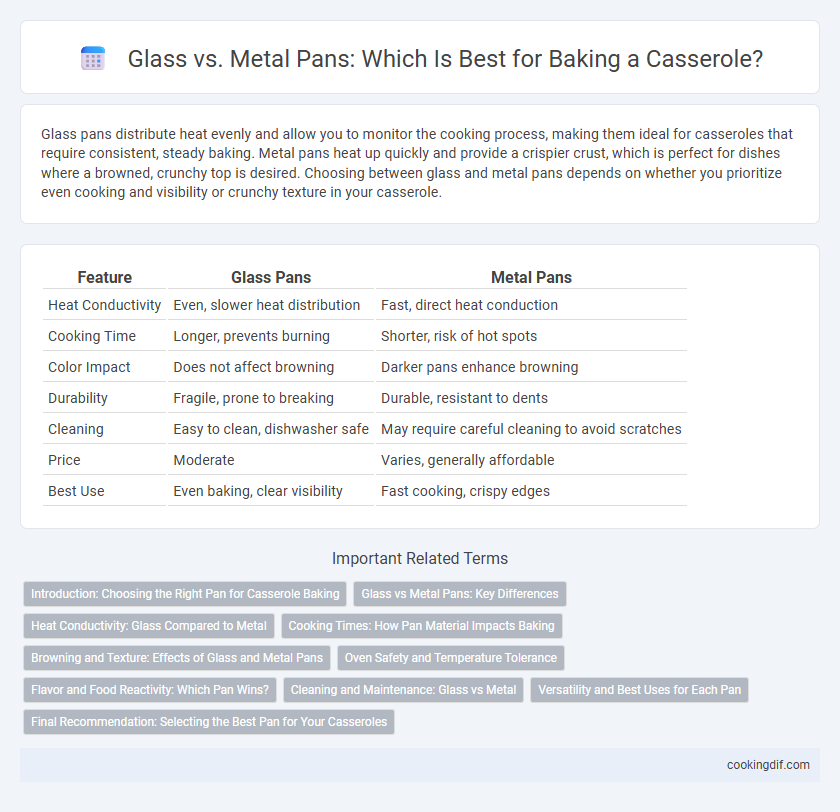Glass pans distribute heat evenly and allow you to monitor the cooking process, making them ideal for casseroles that require consistent, steady baking. Metal pans heat up quickly and provide a crispier crust, which is perfect for dishes where a browned, crunchy top is desired. Choosing between glass and metal pans depends on whether you prioritize even cooking and visibility or crunchy texture in your casserole.
Table of Comparison
| Feature | Glass Pans | Metal Pans |
|---|---|---|
| Heat Conductivity | Even, slower heat distribution | Fast, direct heat conduction |
| Cooking Time | Longer, prevents burning | Shorter, risk of hot spots |
| Color Impact | Does not affect browning | Darker pans enhance browning |
| Durability | Fragile, prone to breaking | Durable, resistant to dents |
| Cleaning | Easy to clean, dishwasher safe | May require careful cleaning to avoid scratches |
| Price | Moderate | Varies, generally affordable |
| Best Use | Even baking, clear visibility | Fast cooking, crispy edges |
Introduction: Choosing the Right Pan for Casserole Baking
Glass pans provide even heat distribution and excellent visibility, allowing cooks to monitor browning during casserole baking. Metal pans heat up faster and promote a crispier crust thanks to superior heat conduction. Selecting between glass and metal depends on desired texture and cooking time, with glass offering slower, more uniform cooking and metal delivering quicker, more intense heat.
Glass vs Metal Pans: Key Differences
Glass pans provide even heat distribution and retain heat longer, making them ideal for slow, consistent cooking in casseroles. Metal pans, typically aluminum or stainless steel, heat up quickly and offer a crispier crust due to higher thermal conductivity. Choosing between glass and metal pans impacts cooking time, texture, and browning in casserole preparation.
Heat Conductivity: Glass Compared to Metal
Glass casserole dishes provide even heat distribution but heat up more slowly and retain warmth longer compared to metal pans, which conduct heat rapidly and promote quicker browning. Metal pans, especially aluminum, offer superior heat conductivity resulting in crispier edges and faster cooking times. The choice between glass and metal impacts baking outcomes, with glass favoring slow, uniform cooking and metal enhancing texture through efficient heat transfer.
Cooking Times: How Pan Material Impacts Baking
Glass pans retain heat longer than metal pans, resulting in slower initial baking but more even cooking throughout the casserole. Metal pans heat up faster and promote quicker browning, often reducing overall cooking times by about 10-15%. Choosing between glass and metal pans impacts not only texture but also precise cooking durations essential for optimal casserole results.
Browning and Texture: Effects of Glass and Metal Pans
Glass pans distribute heat more evenly, promoting consistent browning and a softer, moister texture in casseroles, while metal pans heat up quickly, creating a crispier, browned crust but potentially less even cooking inside. The non-reactive nature of glass preserves the flavor integrity of acidic ingredients, whereas metal pans, especially aluminum, may react and alter taste. Choosing between glass and metal affects the final casserole texture and browning, with glass favoring tenderness and metal enhancing crispness.
Oven Safety and Temperature Tolerance
Glass casserole dishes offer excellent oven safety and can typically withstand temperatures up to 450degF (232degC), making them ideal for even baking and easy monitoring of food. Metal pans tolerate higher temperatures, often up to 500degF (260degC), and provide superior heat conduction for crispier edges but may require careful handling to avoid warping. Choosing between glass and metal pans depends on the specific baking temperature and desired cooking results, ensuring optimal oven performance and food quality.
Flavor and Food Reactivity: Which Pan Wins?
Glass casserole dishes are non-reactive, ensuring that acidic ingredients like tomatoes or citrus retain their original flavor without metallic aftertaste. Metal pans, especially aluminum and uncoated steel, can react with acidic foods, sometimes imparting a slight metallic taste that alters the dish's flavor profile. For pure flavor preservation and chemical stability during baking, glass pans typically outperform metal options in preventing food reactivity and maintaining the intended taste.
Cleaning and Maintenance: Glass vs Metal
Glass casserole pans offer the advantage of being non-porous, making them resistant to stains and odors, which simplifies cleaning and maintenance by usually requiring only soapy water and gentle scrubbing. Metal pans, particularly those made from stainless steel or aluminum with non-stick coatings, can clean up quickly if food residue is prevented from baking on, but they may require more care to avoid scratches and rust. Over time, glass pans maintain their clarity and smooth surface, while metal pans might discolor or degrade if improperly cleaned or exposed to harsh detergents.
Versatility and Best Uses for Each Pan
Glass pans provide excellent heat retention and even cooking, making them ideal for casseroles that require slow baking or retain moisture, such as lasagna or baked pasta dishes. Metal pans, particularly aluminum and stainless steel, heat up quickly and offer a crispier texture, perfect for casseroles with breadcrumb toppings or recipes needing higher temperatures. Glass pans double as attractive serving dishes due to their transparency, while metal pans excel in broiling and are more durable under varied cooking conditions.
Final Recommendation: Selecting the Best Pan for Your Casseroles
Glass pans provide even heat distribution and allow you to monitor the browning of casseroles, making them ideal for recipes requiring precise cooking times. Metal pans heat up faster and deliver a crispier crust with better browning due to their superior heat conduction properties. For versatility and consistent results, metal pans are recommended for casseroles needing a golden, crunchy top, while glass pans suit dishes that benefit from gentle, uniform baking.
Glass vs metal pans for casserole baking Infographic

 cookingdif.com
cookingdif.com